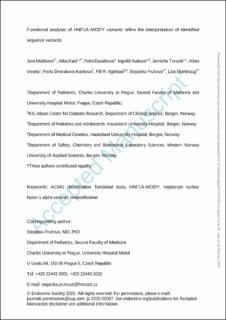| dc.contributor.author | Malikova, Jana | |
| dc.contributor.author | Kaci, Alba | |
| dc.contributor.author | Dusatkova, Petra | |
| dc.contributor.author | Aukrust, Ingvild | |
| dc.contributor.author | Torsvik, Janniche | |
| dc.contributor.author | Vesela, Klara | |
| dc.contributor.author | Kankova, Pavla | |
| dc.contributor.author | Njølstad, Pål Rasmus | |
| dc.contributor.author | Pruhova, Stepanka | |
| dc.contributor.author | Bjørkhaug, Lise | |
| dc.date.accessioned | 2021-02-10T12:23:17Z | |
| dc.date.available | 2021-02-10T12:23:17Z | |
| dc.date.created | 2020-02-18T09:04:11Z | |
| dc.date.issued | 2020 | |
| dc.identifier.citation | Malikova, J., Kaci, A., Dusatkova, P., Aukrust, I., Torsvik, J., Vesela, K., … Bjørkhaug, L. (2020). Functional analyses of HNF1A-MODY variants refine the interpretation of identified sequence variants. The Journal of Clinical Endocrinology & Metabolism, 105(4), e1377–e1386. | en_US |
| dc.identifier.issn | 0021-972X | |
| dc.identifier.uri | https://hdl.handle.net/11250/2727191 | |
| dc.description | This is an Author's Accepted Manuscript Version (postprint) of an article published by Oxford University Press in The Journal of Clinical Endocrinology & Metabolism, available from https://doi.org/10.1210/clinem/dgaa051 | en_US |
| dc.description.abstract | Context
While rare variants of the hepatocyte nuclear factor-1 alpha (HNF1A) gene can cause maturity-onset diabetes of the young (HNF1A-MODY), other variants can be risk factors for the development of type 2 diabetes. As has been suggested by the American College of Medical Genetics (ACMG) guidelines for variant interpretation, functional studies provide strong evidence to classify a variant as pathogenic.
Objective
We hypothesized that a functional evaluation can improve the interpretation of the HNF1A variants in our Czech MODY Registry.
Design, Settings, and Participants
We studied 17 HNF1A variants that were identified in 48 individuals (33 female/15 male) from 20 Czech families with diabetes, using bioinformatics in silico tools and functional protein analyses (transactivation, protein expression, DNA binding, and nuclear localization).
Results
Of the 17 variants, 12 variants (p.Lys120Glu, p.Gln130Glu, p.Arg131Pro, p.Leu139Pro, p.Met154Ile, p.Gln170Ter, p.Glu187SerfsTer40, p.Phe215SerfsTer18, p.Gly253Arg, p.Leu383ArgfsTer3, p.Gly437Val, and p.Thr563HisfsTer85) exhibited significantly reduced transcriptional activity or DNA binding (< 40%) and were classified as (likely) pathogenic, 2/17 variants were (likely) benign and 3/17 remained of uncertain significance. Functional analyses allowed for the reclassification of 10/17 variants (59%). Diabetes treatment was improved in 20/29 (69%) carriers of (likely) pathogenic HNF1A variants.
Conclusion
Functional evaluation of the HNF1A variants is necessary to better predict the pathogenic effects and to improve the diagnostic interpretation and treatment, particularly in cases where the cosegregation or family history data are not available or where the phenotype is more diverse and overlaps with other types of diabetes. | en_US |
| dc.language.iso | eng | en_US |
| dc.publisher | Oxford University Press | en_US |
| dc.subject | ACMG classification | en_US |
| dc.subject | functional study | en_US |
| dc.subject | HNF1A-MODY | en_US |
| dc.subject | hepatocyte nuclear factor-1 alpha variants | en_US |
| dc.subject | reclassification | en_US |
| dc.title | Functional Analyses of HNF1A-MODY Variants Refine the Interpretation of Identified Sequence Variants | en_US |
| dc.type | Peer reviewed | en_US |
| dc.type | Journal article | en_US |
| dc.description.version | acceptedVersion | en_US |
| dc.source.pagenumber | e1377-e1386 | en_US |
| dc.source.volume | 105 | en_US |
| dc.source.journal | Journal of Clinical Endocrinology and Metabolism | en_US |
| dc.source.issue | 4 | en_US |
| dc.identifier.doi | 10.1210/clinem/dgaa051 | |
| dc.identifier.cristin | 1795068 | |
| dc.relation.project | Norges forskningsråd: 240413 | en_US |
| dc.relation.project | Ministry of Health of the Czech Republic: NV18-01-00078 | en_US |
| cristin.ispublished | true | |
| cristin.fulltext | postprint | |
| cristin.qualitycode | 2 | |
